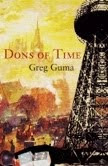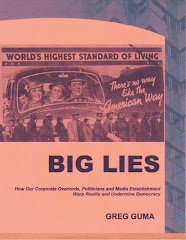From Planet Pacifica
My interview for Pacifica Executive Director was supposed to take place in late September, 2005, but Hurricanes Katrina and Rita forced the Board to reschedule for the end of October. In the meantime, it was business as usual -- writing and editing for Vermont Guardian, a weekly newspaper I had launched with a partner and investors a year and a half earlier.
My interview for Pacifica Executive Director was supposed to take place in late September, 2005, but Hurricanes Katrina and Rita forced the Board to reschedule for the end of October. In the meantime, it was business as usual -- writing and editing for Vermont Guardian, a weekly newspaper I had launched with a partner and investors a year and a half earlier.
The most significant feature I wrote while waiting turned out to be “Mission Improbable,” a report on the controversial theories of David Ray Griffin, a theologian who had examined the available evidence about the 9/11 attacks and published two books on the subject. For several years, the public had been urged to ignore “outrageous conspiracies theories” about the horrific events that set in motion the so-called war on terror. But as Griffin argued in lectures, the official explanation also required the acceptance of a theory, one involving a massive intelligence failure, 19 Muslim hijackers under the sway of Osama bin Laden, and the inability of the world's most advanced Air Force to intercept four commercial airplanes.
The official story didn’t seem to convincingly explain the events; in fact, certain claims might even defy the laws of physics. Yet mainstream media outlets – and even some Pacifica journalists – consistently declined to examine the technical and exhaustively documented case Griffin had developed.
My October 2005 report, which later resulted in the imaginative charge that Pacifica had hired a “non-credible fringie”
”Both the Bush administration and Larry Silverstein, who owned Building 7 and had leased the WTC earlier in 2001, clearly benefited,” I argued. “How? Silverstein collected $7 billion in insurance on property that was losing money and faced major problems caused by asbestos, while the administration needed ‘an archetypal event’ in order to implement the plans to invade Afghanistan and Iraq that several key administration figures had been developing for more than a decade.”
US officials may not have played a role, I acknowledged. Perhaps they only covered up embarrassing facts to spin the story and exploit the tragedy. But there was another possibility – that some members of the intelligence community knew something in advance, but didn't prevent the attacks and persuaded the administration to help with a cover-up. An even more disquieting alternative was that someone in the executive branch actually did know in advance, or even provided a push.
Disturbing? Obviously. Preposterous? Maybe, maybe not. It certainly wouldn't be the first time elements within the government or business orchestrated a pretext for aggression, and lied afterward, to achieve a long-term aim. After all, we now know that events were manipulated to justify the Spanish-American War, the U.S. entry into World War II, the expansion of the Vietnam War, and the current Iraq war. Scholars have even challenged official accounts of the atomic bombing of Hiroshima and Nagasaki.
How could such a conspiracy be kept secret? I asked Griffin. "We don't know the secrets they have kept," he replied. "The Manhattan Project [to create the atomic bomb] was kept secret for a long time, as well as a war in Indonesia during the 1950s. Things are compartmentalized, with information available on a need-to-know basis. Most people are afraid for their jobs," he continued, adding that "if they talk and disobey, they can be imprisoned and worse." Plus, when people do speak out the press frequently ignores or attempts to discredit them.
Griffin’s analysis raised troubling questions, I concluded, but “not much can be said with complete certainty, except that without 9/11, George Bush would not have been able to declare himself a ‘war president’ and there would have been no convincing reason to expand the federal government's power through legislation like the USA PATRIOT Act.” Given the administration's discredited claims about Iraqi leader Saddam Hussein's connection to the attacks and weapons of mass destruction, “it didn’t stretch credulity to conclude that the public hasn’t yet heard the whole story.”
This in turn led me to consider anxiety, more specifically the tendency of opportunists and demagogues to have people worry about the wrong things. I’d just reviewed False Alarm: The truth about the epidemic of fear, in which New York internist Marc Siegel explained that the basic problem lies in the amygdala — the Brain’s central station for processing emotions. Once it detects a threatening situation, it pours out stress hormones. If the stress persists too long, it can malfunction, overwhelm the hippocampus (center of the "thinking" brain), and be difficult to turn off. In the end, this "fear biology" can wear us down rather than protect us, inducing paralysis and even making us susceptible to diseases that we might otherwise resist. Linking the reaction to the current "war on terror," Siegel charged the government and media with encouraging people to be unreasonably afraid.
Here’s a tip: One of the best ways to overcome fear is to “re-educate” yourself, putting risks in a more realistic perspective; in short, to focus less on the unlikely, stop exaggerating potential impacts and purge the "high-pressure misinformation that is being shot into our brains." Humor also helps. But the first step is to realize when you’ve been conned and learn how to realistically assess the risks.
In any case, as I flew west I wondered whether Pacifica’s metaphoric amygdala might be misfiring due to long-term stress. Based on what I’d read and heard, it looked plausible. At the very least some Pacificans weren’t dealing with their fears very rationally. My preliminary conclusion was that the organization could use less drama, some fresh perspectives, and a lighter touch.
(Originally posted on March 27, 2008)
Next: Applying for the Dream Job from Hell
































